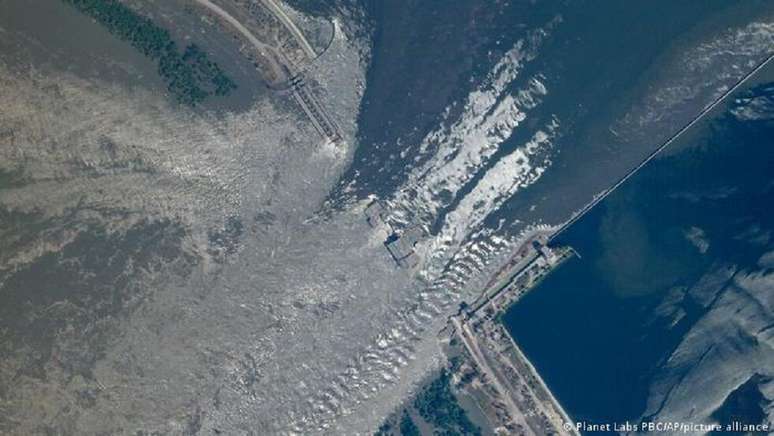Ukraine’s environment minister says up to 800 tonnes of lubricating oil may have been dumped into the water.
One day after the destruction of the Kakhovka dam in southern Ukraine, the extent of the catastrophe is becoming increasingly clear. According to the United Nations, thousands of people on both sides of the front will be affected by the severe consequences of the floods. The collapse of the dam is also a catastrophe for the environment and for the local water supply.
“We assume that parts of the wilderness will be destroyed forever,” Ukraine’s Environment Minister Ruslan Strilets told DW in an interview.
He classified the dam failure as “the biggest environmental crime committed since the first day of Russia’s “invasion” of Ukraine in February 2022.
According to Strilets, large swathes of a national park have been destroyed, as has much of the Emerald Network, a European network of protected areas set up to preserve endangered species and habitats across the continent.
His portfolio estimates that “perhaps 600 to 800 tons of lubricating oil were dumped into the water.”
Other unverified sources from the Ukrainian government even mention that so far about 150 tons of oil have flowed into the Dnipro River and another 300 tons could still leak.
600 to 800 tons of lubricating oil may have been dumped into the water.
(Source: Planet Labs PBC/AP/picture alliance)
Fauna and Flora
Furthermore, flora and fauna must also be affected. The oil is highly toxic to all aquatic and terrestrial life. Even small amounts are enough to contaminate soil and water. Exact damage data is not yet available.
“This is a barbaric act, a real one ecocide and a future humanitarian catastrophe. We predicted this situation and unfortunately, the worst-case scenario has been confirmed,” Strilets said, adding that around one million people are expected to be left without water.
Shortly after the explosion, Ukrainian Prime Minister Denys Schmyhal spoke of the risk of flooding in up to 80 cities. Scientists from the Magdeburg-Stendal University of Applied Sciences in Germany have calculated, in an initial model, that 60,000 people could be affected, of whom a third are at risk.
According to Kherson region governor Olexander Prokudin, there are 16,000 people in the risk zone. The European Union speaks of hundreds of thousands of civilians whose lives would be in danger. There is still no information on possible injuries.
“The direct consequences are similar to any other flood,” explains Nickolai Denisov of Zoi Environmental Network, a Geneva-based NGO. However, what differentiates this catastrophe from other floods is the speed of the water.
“Natural areas usually don’t get a lot of water. Even more at this rate. So this will cause direct damage.”
Denisov emphasizes that especially the flooding of industrial areas will cause problems.
“In that case, if the water enters the industrial zonel, one is generally not prepared for this. A the pollution is carried out of the area. It’s not the kind of pollution that comes from industrial wastewater. So it’s an added burden, and that’s bound to happen.”
“Unprecedented environmental consequences”
Olena Kravchenko, director of Ukrainian NGO Environment People Law, told the British Guardian newspaper that the dam failure could have “unprecedented environmental consequences” in areas downstream of the Dnipro, Dnipro Estuary and Black Sea coastal ecosystems Agriculture can also be affected by chemical pollution and lack of running water.
The International Fund for Animal Welfare (IFAW) believes that while local wildlife populations are harmed, many animals will return after the disaster.
However, the situation has worsened Petswhich are often not evacuated with people.
“We have already received reports that nearby animal shelters are overwhelmed with calls for distress. In New Kakhovka, in Russian-occupied territory, a small zoo has been completely flooded. All animals except swans died” Natalia Gozak, head of IFAW wildlife rescue in Ukraine, said in a statement on Tuesday.
In addition to the dam breaking, the war has already caused serious damage to the environment. Much of the country’s soil and water are polluted with munitions of war and from the destruction of industrial plants, with the leakage of chemical products.
Disorganized local waste disposal is also a growing problem. Wildfires, shell damage and illegal logging have also destroyed significant parts of the forest in the conflict area.
Ukraine and Russia accuse each other of blowing up the dam. At an emergency meeting of the ONO Security Council, the Ukrainian ambassador said it was an “ecological and technological act of terrorism”.
This content is a work originally published by the German DW agency. The opinion expressed by the publication does not reflect or represent the opinion of this portal or its collaborators.
Source: Terra
Rose James is a Gossipify movie and series reviewer known for her in-depth analysis and unique perspective on the latest releases. With a background in film studies, she provides engaging and informative reviews, and keeps readers up to date with industry trends and emerging talents.







